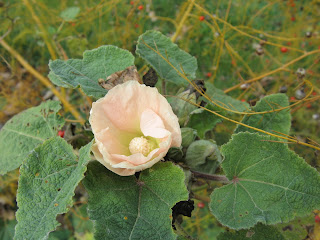Click on images to view larger
The front bed of our house needed a major revamping. It was completely overgrown with grass, alfalfa, and field bindweed among other things. We pulled out some over sized burning bushes, which left the terrain uneven. The soil is heavy with clay and has lots of rocks. To make matters worse, the base of the ill advised concrete porch that some genius poured up against the foundation of our 160 year old house was uncovered and even undermined at points.
06/19/2012
The design I came up with is an amalgamation of several techniques I have either tried or read about. The goals are to collect and store water in the bed while diverting it away from the house. We also want to smother the weeds and build a healthy productive bed, that eventually will be a mixed garden of flowers herbs and vegetables.
If you can read my scrawl, this drawing gives a cross section of the design.
7/12/12
I used a string level to even the grade on top, near the porch, and I cut a curvy but level
swale into the ground. I tamped and filled the slope up to the porch to a nice even grade away from the porch with the clay I dug. All the decent looking black dirt I pulled out went to the other side of the house into a small terrace where Nikki's serviceberry is now.
7/12/12
7/17/12
7/17/2012
7/25/2012
I got the rough level from the string. Spraying a little water over everything helped with compacting the slope. The water pooled in the swale revealing the low spots. Once it dried again, it was easy to see where I needed to scrape out soil to get a perfectly level bottom.
7/25/12
8/5/2012
8/19/12
Nikki is weeding the hens and chicks while I install the kill layer.
8/19/12
8/19/2012
8/19/12
Our neighbor gave us some old burlap sacks that I cut open and layed out in the swale so the logs wouldn't puncture the wet cardboard and newspaper. The burlap formed nicely to the swale edge. The open part at this end overflows onto a flat part of the driveway that I'm hoping will be effective as a level spillway.
8/22/12
8/25/12
9/6/12
No need for a gym membership when you've got a shovel and a wheel barrow!
9/14/12
After the logs were in place I covered everything with some slightly aged wood chips. Above that the layers are just compost from bins I started this spring. They were only half broken down, but had heated up nicely when I first filled the bins. The bulk of the material is just wood chips mixed with coffee grounds, so I plan to cut leaf mulch from dynamic accumulators such as comfrey and yarrow after planting this Spring. This should help add minor nutrients that may be lacking from my compost.
9/20/12
I set large stones with flat tops on top of the swale edge and filled in on either side of them with compost leaving the flats exposed for stepping stones.
9/25/12
I finally tuck pointed the porch foundation, so I can finish the West side of the bed.
10/11/12
Here it is after a little grading, a layer of cardboard, some logs, and layers of mulch and compost.
10/11/12
One of my goals for next Spring is to install some Rain barrels over by the remaining burning bush that can be used to irrigate this area, as well as the 2'x6' box next to it.
In the early Spring we will get a pickup load of mushroom compost from River Valley Ranch and top off the bed. Then its ready for planting.
This is my first attempt at several different design ideas, so wish me luck!
I'm calling it my Hugelkultur in a Swale with Lasagna on top Rain Garden. The neighbors probably think I'm crazy, and it's entirely possible that they are right.

















































